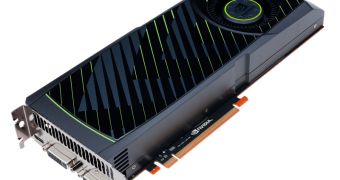There's been quite a lot of talk about NVIDIA's forthcoming GTX 570 graphics card lately, and, right as everyone expected, the GPU manufacturer decided to finally officially roll out the second member of the GTX 500 series Fermi cards today, on the 7'th of December. Quite naturally, as in the case of the GTX 580 before it, some pre-launch leaks have already hit the Internet, ranging from products being listed for sale online and up to full-fledged reviews, complete with detailed performance benchmarks, so we pretty much knew what to expect from the brand-new NVIDIA card even before its official release.
The NVIDIA GeForce GTX 570 packs 480 stream processor cores, the core clock being rated at 732 Mhz, while the shader clock has been set at roughly 1464MHz, as well as 1280MB of GDDR5 memory, sporting a 3800MHz effective memory clock and a 320-bit memory interface.
Moreover, the card can output a maximum of 2560 x 1600 pixels video resolution and comes equipped with 1 x mini HDMI and 2 x DVI ports.
Furthermore, the card provides full support for NVIDIA 3D Vision and NVIDIA Surround technologies, as well as the graphics horsepower and video bandwidth needed to experience games and high-definition Blu-ray movies in stereoscopic 3D on a single display or spanning across three screens for an immersive gaming environment.
Additionally, the card also supports NVIDIA's SLI technology, the industry’s most scalable multi-GPU platform, meaning that gamers will be able to enjoy a superior experience by leveraging the graphics power of two GTX cards.
Last, but certainly not least, NVIDIA reveals the fact that that the card will be available starting right from today from the world’s leading add-in card partners, including ASL, ASUS, Colorful, ECS, EVGA, Gainward, Galaxy, Gigabyte, Innovision 3D, Jetway, Leadtek, MSI, Palit, Point of View, PNY, Sparkle, Zotac and others (so you know that a flood of GTX 570 announcements is coming your way).
And while NVIDIA doesn't provide any info on the pricing, the leaks we've mentioned earlier seem to point out that the standard versions (those providing roughly the same specs and configuration as the reference card) will sell for somewhere in the vicinity of 350 US dollars.

 14 DAY TRIAL //
14 DAY TRIAL //